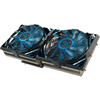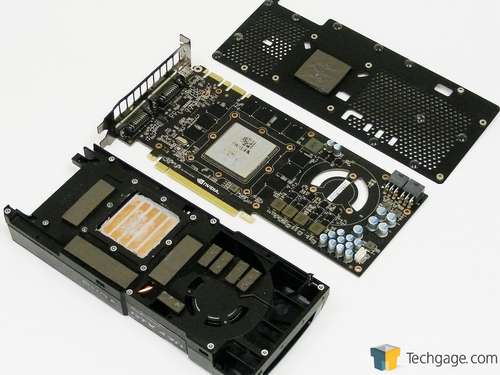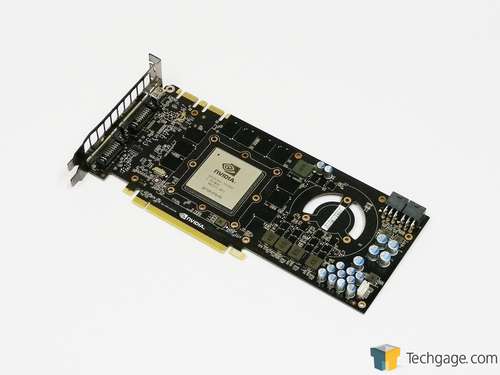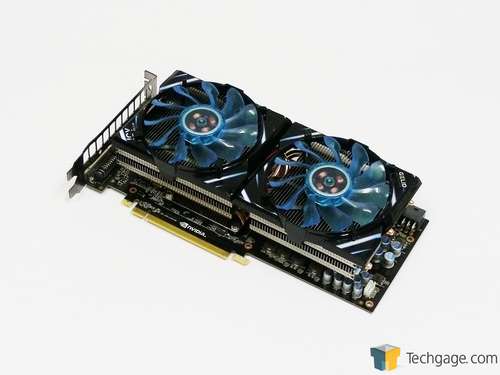- Qualcomm Launches Snapdragon 4 Gen 2 Mobile Platform
- AMD Launches Ryzen PRO 7000 Series Mobile & Desktop Platform
- Intel Launches Sleek Single-Slot Arc Pro A60 Workstation Graphics Card
- NVIDIA Announces Latest Ada Lovelace Additions: GeForce RTX 4060 Ti & RTX 4060
- Maxon Redshift With AMD Radeon GPU Rendering Support Now Available
GELID Rev. 2 Icy Vision GPU Cooler Review

Of all the components we shove into our PCs, the hardest to keep cool is the graphics card. With current models easily able to reach 80°C or higher at full load, purchasing an after-market cooler can be tempting. GELID has just a single GPU cooler model, the Rev. 2 Icy Vision, so let’s see how effective it is against our hot GTX 470.
Page 2 – Installation & Testing
On the operating table is EVGA’s GeForce GTX 470. It’s big, it’s hot and it’s loud when left to ramp up to full speed, so it’s an ideal candidate. Put the kids to bed, because Techgage is about to get a little wild and strip the GPU naked!
Installation will vary from card to card so I won’t go into great detail, but the first step with our GPU was to remove the stock cooling solution. This was done in two parts; the first of which is the rear cover that acts as a second heatsink to pull heat away from the back of the GPU. After removing some screws from the rear cover, a few more from the back of the PCB under the cover and two from the PCI bracket, the stock heatsink came off cleanly.
The stock fan was disconnected and then it was time for some clean up. I always wonder if a middle-aged, cafeteria lunch lady with a hair net and a ladle applies the TIM at the factory, because it’s always slopped on. Luckily, some isopropyl alcohol and a handful of cotton swabs made short work of this and the GELID system was ready to be installed. Thermal tape was applied to the required heatsinks, which were then applied onto the corresponding circuitry.
The standoffs were attached to the mounting plate and the mounting plate attached to the main heatsink. Finally, fresh TIM was applied to the GPU processor and the two parts were secured together by screws inserted through the original mounting points on the back side of the PCB.
The entire removal, clean up and installation process took about 90 minutes, and most of this time was spent fumbling with the thermal tape; trying to remove it from the backing. As easy as it was, there were some issues with the installation.
Users are left to look at very small, poor quality diagrams to figure out which heatsinks are needed. Since there is no break-down of each individual card for obvious reasons, some users may be left almost guessing at which heatsinks go where. I decided to download the PDF version from GELID’s website since it would allow the image to be magnified, but the link was not active. I’m confident in the installation, but it may cause a problem for some.
The second issue is that fully assembled, Icy Vision is about 3/4 of an inch taller than the stock heatsink, meaning it could block off some SATA ports on certain motherboards. Models with angled SATA ports or those using angled cables will be fine, but in my case all but one port was blocked, meaning a second hard drive and an optical drive were rendered useless. Hopefully these two hiccups will be offset by the performance.
Testing was performed using two applications. The first is OCCT to fully load the GPU in order to generate as much heat as possible thanks to the built in GPU test. The second was MSI’s Afterburner. This handy little tool pulled double duty by allowing us to record temperatures but also to overclock the GTX 470. In addition to this, it allows for voltage increases meaning we were able to reach higher-than-normal frequencies while generating even more heat.
With the test system sitting at the desktop for 5 minutes, the idle temperature was recorded followed by a 15 minute run with OCCT. This was done with the GPU at stock clocks and while overclocked with both the stock heatsink and GELID cooler installed. Some may choose to run their tests longer but in my experience, GPUs top out at the maximum temperature within this time.
The final overclock used for testing was 731 MHz for the core, 1470 MHz for the shaders since the two are linked with no option to set them individually, and a whopping 4000 MHz (QDR) for the memory! A voltage increase of 0.037 volts was required for the core to remain stable but no matter how much voltage was put into the GPU, it simply would not stay stable for a full 15 minute run at higher clocks.
The final point to note is that because the GELID cooler does not feature pulse width modulation (PWM) to control the speed of the fans based on temperature without a separate controller, the stock cooler that does was run at 100% for all tests to ensure an even comparison.
The components of the test system are:
|
Component
|
Techgage Test System
|
| Processor |
Intel Core i3-530 – Dual-Core (2.93GHz)
|
| Motherboard |
GIGABYTE GA-H55M-USB3 – H55-based
|
| Memory |
G.Skill ECO 2x2GB DDR3-1600
|
| Graphics |
EVGA GTX 470 1280MB
|
| Audio |
On-Board Audio
|
| Storage |
Mushkin Callisto Deluxe 60GB SSD
Western Digital Caviar Black 640GB |
| Power Supply |
SilverStone Strider Gold 750W
|
| Chassis |
Lian Li PC-50WB
|
| CPU Cooling |
Stock
|
| Et cetera |
Windows 7 Ultimate 64-bit
|

Not too shabby! A 21 degree difference in temperatures with the GPU overclocked and under full load. I’d say that the GELID cooler certainly does what it was designed to do but some readers might be wondering why anybody would need an aftermarket heatsink if the stock and overclocked temperatures of the EVGA stock heatsink are virtually the same.
The main reason in this case is for noise reduction. The stock cooler on the GTX 470 is very capable, even given the amount of heat the GPU generates. The trade off is that it’s incredibly loud while running at 100%. Just for fun I ran the stock cooler with the fan on Auto so the speed would increase in relation to the temperature. It spun up to 81% while under full load with stock clocks and up to 89% while overclocked. Even with the GELID cooler running at 100%, it produced much less noise while keeping temperatures incredibly low.
Not a bad way to get back in the GPU cooler scene. so let’s bring this one home.
Support our efforts! With ad revenue at an all-time low for written websites, we're relying more than ever on reader support to help us continue putting so much effort into this type of content. You can support us by becoming a Patron, or by using our Amazon shopping affiliate links listed through our articles. Thanks for your support!







